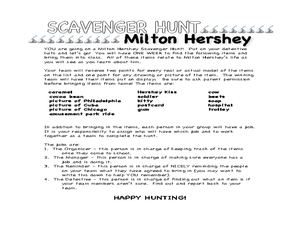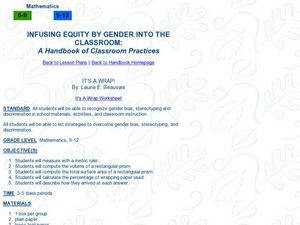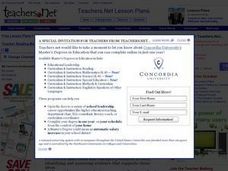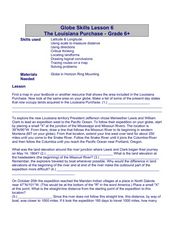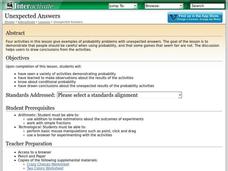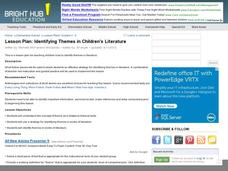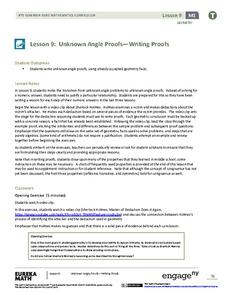Curated OER
A History of Conflict
Young scholars explore issues contributing to current tensions between Pakistan and India, drawing conclusions about how the conflict came about and where it may be heading. They Participate in an in-class "diplomacy summit"; create a...
Curated OER
Waldseemuller's Map: World 1507
Learners investigate the 1507 word map. In this world geography lesson, students examine the details of each section of the map and then draw conclusions about how the people of 1507 understood the world. Learners are evalated on...
Curated OER
Milton Hershey Scavenger Hunt
Students participate in a scavenger hunt. In this Milton Hershey lesson, students prepare for a trip to the Hershey Museum in Pennsylvania by completing a scavenger hunt. Students draw conclusions on their findings.
Curated OER
Energy Efficient Homes
Students observe and gather data from a model simulated home. In this efficiency lesson students examine the factors that influence energy efficiency, complete a lab activity then draw conclusions from their data.
Curated OER
Rivers Through Time
Students read or have the book A River Ran Wild read to them. They discuss and reflect on the messages presented in the book. Students use their listening comprehension skills to draw conclusions. Students articulate several examples of...
Curated OER
Mock Investigation
Students explore detective investigations. In this introduction to mysteries lesson, students role play eye witnesses and investigators related to a "crime" committed in their classroom. Students collect evidence and record information,...
Curated OER
Plate Tectonics
High schoolers research separate elements of the theory of Plate Tectonics, then share that information with each other, drawing conclusions from the culminated information.
Curated OER
For The Birds
Student make bird feeders and describe feeding behaviors. In this bird feeder lesson plan, students construct simple bird feeders. They then put them outside and observe the feeding behaviors of birds. Then they graph the number of birds...
Curated OER
Scientific Method in Action
Students investigate the current environmental movement by cleaning up their own campus. In this environmental care activity, students practice cleaning their "environment" by picking up trash on their campus and decrease litter by...
Curated OER
Bird Buffet
Fifth graders investigate how birds use their beaks. In this agriculture lesson, 5th graders use tools to simulate how birds gather food with their beaks. They then draw conclusions about certain types of beaks and what types of food a...
Curated OER
Infusing Equity in the Classroom by Gender
Students investigate the idea of gender descrimination in the classroom. In this algebra lesson, students collect data in stereotyping, and gender bias in the classroom, school materials and activities. They graph and analyze their...
Curated OER
Random Sampling
In this random sampling worksheet, students compare data collected by a random sample to data collected by an actual count using pieces of paper with numbers written on them. They compare their data for the actual count to the random...
Curated OER
Reading Comprehension: Jamaica Louise James
In this reading comprehension worksheet, students cut out 5 bookmarks. Each bookmark focuses on a story element in the book Jamaica Louise James by Amy Hest. Students answer the questions on the bookmarks. Included are: making...
Curated OER
Bar Graph Lesson
Students make a bar graph. In this graphing lesson, students discuss why bar graphs are used and are shown bar graph examples. Students create their own bar graph to compare the heights of different things around the world. Students...
Curated OER
Logic- Always and Sometimes
Second graders investigate logical reasoning. In this math vocabulary lesson, 2nd graders explore the words: always and sometimes while evaluating story problems. Students create images on KidPix to illustrate their understanding of the...
Curated OER
Cause and Effect SDAIE Lesson
Fifth graders read two Mexican folktales and discuss cause and effect. They draw a cause and effect relationship from one of the stories.
Curated OER
Globe Skills Lesson 6 The Louisiana Purchase
Learners explore the Louisiana Purchase territory. In this geography skills lesson, students use map skills in order to plot and note latitude and longitude, measure scale distance, and locate landforms that were part of the Louisiana...
Curated OER
Globe Skills Lesson 2: Paving the Way for Columbus
Students explore the expedition of Christopher Columbus. In this geography skills lesson, students consider the technological advances that made Columbus's expedition possible as they complete a latitude and longitude activity.
Curated OER
Post-Reading Strategies
Students practice post-reading strategies. For this reading comprehension lesson, students review pre-reading strategies, then read a handout entitled "Thirteen Reasons Our Ancestors Migrated." Students complete a post-reading worksheet...
Curated OER
Unexpected Answers
Students explore the concept of fairness. In this fairness lesson, students play four probability games. Students determine who has the best chance of winning each of the four games. Students discuss which games gave an unfair advantage.
Curated OER
Identifying Themes in Children's Literature
Identifying themes in literature is the focus of the language arts lesson plan presented here. Learners read short pieces of fiction and practice the skill of identifying the themes present in each one. The bulk of the lesson consists of...
Curated OER
Make a Solar Sill
Students design a solar still and purify water. In this earth process and design lesson, students observe how the heat of the sun helps to purify water. Students analyze why this could be helpful on a desert island. Students record...
Curated OER
Bering Sea Buffet - A Foodweb Activity
Life in the Bering Sea, food webs, and the ocean ecosystem are introduced with a map activity. The lesson starts as kids explore maps and images of the Bering Sea, then it kicks into high gear as they start to discuss the types of...
EngageNY
Unknown Angle Proofs—Writing Proofs
What do Sherlock Holmes and geometry have in common? Why, it is a matter of deductive reasoning as the class learns how to justify each step of a problem. Pupils then present a known fact to ensure that their decision is correct.




